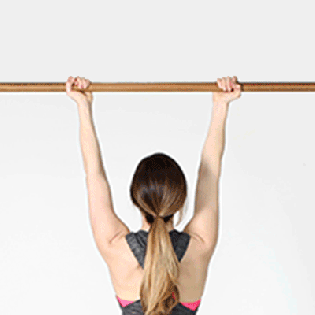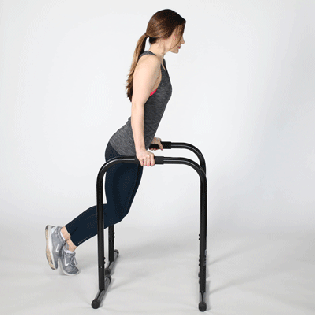The Deadlift. It is the quintessential weightlifting exercise. According to David Robson, a bodybuilder, personal trainer, and contributor to Bodybuilding.
“In my experience as an athlete, and based on the results witnessed by many of my personal training clients, the deadlift, if performed correctly, will build unparalleled mass while strengthening all the major muscle groups.Yes, many will argue that the squat is the King of Exercises, and will contribute to more strength and size gains than any other exercise.While it is true that the squat does rank as one of the best size builders (and on this basis alone should be included in everyone’s program), the deadlift, in my opinion, builds the upper and lower body like no other movement.”
The deadlift is done by simply grasping your free-weight bar (with as many weights as you can feasibly – not comfortably – lift) and lifting up until you stand up with the bar hanging in front of you, arms extended.
1. Increased Fat Burning
Alwyn Cosgrove, a personal trainer and fitness author, recently wrote about a study where: “Overweight subjects were assigned to three groups: diet-only, diet plus aerobics, diet plus aerobics plus weights. The diet group lost 14.6 pounds of fat in 12 weeks. The aerobic group lost only one more pound (15.6 pounds) than the diet group (training was three times a week starting at 30 minutes and progressing to 50 minutes over the 12 weeks).
The weight training group lost 21.1 pounds of fat (44% and 35% more than diet and aerobic only groups respectively). Basically, the addition of aerobic training didn’t result in any real-world significant fat loss over dieting alone.”
Lifting weights and resistance training will burn more fat than just dieting or dieting with cardio exercise alone.
2. Better Posture
Deadlifting increases your core strength and adds to core stability, according to Robson. Deadlifting targets all of the muscles responsible for your posture and enables you to keep your back straighter during regular daily activities.
3. More Muscles Worked
The Deadlift works more muscles than any other exercise, including the squat. The lift engages all of the major muscle groups, according to exercise physiologist Kevin Farley. If you need to do one exercise, this is the one to do. The Deadlift works your lower and upper body, including your back muscles.
4. Increased Real Life Lift
When you do other lifting exercises, like a bench press, for example, you’re not doing anything you might really do in real life. When are you ever going to have the need to lay on your back and push something in the air — unless you’re giving your two-year-old “flying lessons.” The Deadlift develops the muscles you need to actually carry something, like a bucket of water, those heavy grocery bags or your neighbor’s dining room table.
5. It’s Safe
The Deadlift is one of the safest weightlifting exercises you can perform. You aren’t going to get pinned under the weight or have to worry about it pulling you over backward. If you get into trouble, you can simply drop it…making for a loud bang, no doubt, but no damage. You also don’t have to have a spotter to perform this exercise.
6. Improved Grip Strength
According to Outlaw Fitness:
“Deadlifts are renowned for their ability to build massive amounts of grip strength, and for good reason. Your fingers are literally the only things connecting you to the weight of the bar. Your forearms have to work incredibly hard as you progress in weight to keep the bar from falling out of your hands. Subsequently, your grip strength grows by leaps and bounds.”
7. Increases Hormones
Now don’t worry, these aren’t the hormones that will make you more emotional! Instead, by doing at least 8 to 10 repetitions of Deadlifts with significant weight, you can increase the amount of testosterone and growth hormone produced by your body.
Testosterone increases muscle growth and improves muscle repair while growth hormone, which is produced by your pituitary gland, promotes tissue healing, bone strength, muscle growth, and fat loss.
8. Cheap and Easy
A lot of exercises require a lot of equipment, special shoes or whatever. Not the Deadlift. Just a bar with some weight. Pick it up. Simple. You can usually find free weights and a bar at a thrift store – or being given away by a friend – making it even cheaper.
9. Increased Cardio
Believe it or not, doing 10 repetitions of Deadlifts will increase your cardiovascular ability. You might want to make sure you have somewhere to sit down when you’re done!
10. Prevents Injury
The Deadlift can help prevent injuries by increasing the strength of your muscles around critical tendons and ligaments. Supporting joints with strong muscles is crucial to preventing injury, especially in the hamstrings and lower back, according to Outlaw Fitness.
CHANGE STARTS WITH YOU!
Ready to get started? Fill out the form here so we can help you achieve your goals! Let's do this!
World No.1 Nutrition Supplement
80% Nutrition - 20% Exercises
At Herbalife Nutrition, our commitment to make the world’s best nutrition products is the same as our commitment to helping people reach their goals. That’s why we’re offering Members and customers the opportunity to meet those goals as Herbalife Nutrition Preferred Members!
Preferred Customer – is a person, who is registered as a Herbalife Distributor. Being registered as a distributor does not oblige the person to in reality distribute. It only signifies that the person is registered on the Herbalife computer database and so is qualified to receive a 25% and 35% discount on all purchases.
In the next step, you will be asked two (2) important questions during the signup process:
As a fresh Distributor, you will receive all the information that you require in order to get a great start off:
Then complete the Sponsor Information
Please select your Country of Residence* and Language
Enter Sponsor's Herbalife ID Number: → 10Y2193890
First 3 letters of Sponsor's Last Name: → GUE












































